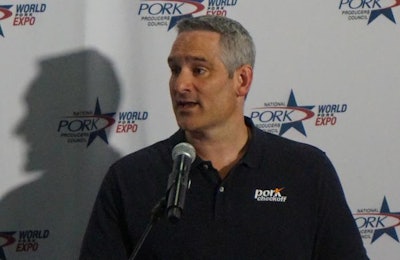
The 2014-2015 highly pathogenic avian influenza outbreaks in the U.S. provided a sobering reminder to all of animal agriculture the severity of the economic impact that can result from the introduction of a foreign animal disease into the U.S. Terry O'Neel, president, National Pork Board, speaking at the World Pork Expo in Des Moines, Iowa, on June 7, cited an Iowa State University study which estimated the impact of an outbreak of foot-and-mouth disease in the U.S. on the swine and cattle industries would run $12.8 billion per year.
A guide for swine producers is currently being developed which will provide instructions for how to implement a plan for individual farms. Dr. Patrick Webb, director of swine health programs, National Pork Board, said that the guide is expected to be completed by early 2018 and will be posted at www.SecurePork.org.
Webb said that swine producers will need “improved biosecurity and rock solid traceability.” The Secure Pork Supply plan was developed from pilot programs in Iowa. He said that lessons learned in foreign animal disease outbreaks in other species, like highly pathogenic avian influenza in poultry, as well other disease outbreaks like porcine epidemic diarrhea virus have all been incorporated in the plan.
“Biosecurity, traceability and surveillance are the three key points of the secure pork plan,” said Webb. “Producers have to be aware of the disease, be able to detect the disease and then deal with it.” The significant aspect is preparedness, according to Webb. “Producers need to do everything on the front end before there is an outbreak,” he said.
Participation is optional, but encouraged
Participation in the Secure Pork Supply plan is voluntary, but producers are being urged to participate. Farms that participate in the plan will be able to move pigs sooner in case of an outbreak, which means less disruption to their normal operations. There can be other benefits to producers from participation, according to Webb. He said that intensified biosecurity plans to exclude foot-and-mouth disease can also help to reduce losses from other diseases.
Webb said that to prepare to implement a Secure Pork Supply plan, producers will need to know what their operations will do when movement of pigs is halted. Producers will also need to know how they will dispose of animals if there is a need to depopulate a farm or if there is a catastrophic loss. All participating farm will need to have a premise ID.
The Secure Pork Supply plan has been produced in a collaborative effort between, the National Pork Board, the National Pork Producers Council, the American Association of Swine Veterinarians, researchers from several universities and other state and federal partners.


















